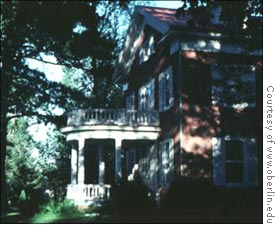
| << Front page | Features | October 27, 2006 |
Oberlin’s Mysteries of History: 315 East College St.
 |
||
| This Old House: The historic building has been a major part of Oberlin history and will continue to contribute to the town with a new use: the Community Music School. | ||
Once a part of the Underground Railroad and home to an Oberlin College president and professor, the Burrell-King House has played a major part in American freedom and Oberlin music education. The colorful Oberlin historic landmark will continue to function as a community center: the house is to be converted for use as the Oberlin Community Music School, a pre-collegiate music institute associated with the Conservatory. The property is located at 315 East College and has already enjoyed a variegated history since it was erected in 1852.
Originally, the house was a Greek revival style brick farm house, home to abolitionist Jabez Lyman Burrell (1806 – 1900). Jabez hailed from western Massachusetts and was a disciple of John Jay Shipherd, one of the founders of the College.
Burrell’s brother Robbins (1799 – 1887), was the station master in the Lorain County section of the Underground Railroad. Together, the two hid runaway slaves in the grainhouse which stood behind the main house. At night, Captain Arron Root would travel up the Black River to transport the runaways across Lake Erie into Canada.
The brothers played with fire, often welcoming slave hunters into the house. Such efforts were made to maintain an anti-abolitionist front as good Christian farmers. It is possible that eighteen-year-old runaway John Price was hiding there when arrested by a federal marshal.
Price had escaped from a Kentucky slaveholder only a few years prior, and had been residing in town for approximately two years. Ardent Oberlin abolitionists followed the U.S. marshal to Wellington and were able to free him. Upon his rescue, Price was brought to the home of College President James Harris Fairchild. This event later came to be known as the famed Oberlin-Wellington Slave Rescue.
As a charter member of the Board of Trustees, Jabez opened up his property for use. Classes of the Sheffield Manual Labor Institute were held at the farm. James Bradley, Oberlin’s first black student, studied there.
In a short memoir composed about his life from slavery to freedom, Bradley reflected upon his educational experience: “I am so ignorant, that I suppose it will take me two years to get up with the lowest class in the institution. But in all respects I am treated just as kindly, and as much like a brother by the students, as if my skin’s as white, and my education as good as their own.”
From 1884 to 1934, the property was home to Henry Churchill King, College President from 1902 to 1927.
“They reworked and expanded it to accommodate a large family and to make it into a center for the community,” said Patricia Murphy, executive director of the Oberlin Heritage Center.
King himself had graduated from the College in 1879, and then from the Oberlin Theological Seminary in 1882. He also taught theology on campus, and worked for the development of what he termed the “whole man,” which led to an increased emphasis on the study of music, fine arts, morals and religion.
At the conclusion of World War I, he was chosen by American President Woodrow Wilson to work on the King-Crane Commission with active Democrat Charles R. Crane concerning the various lands previously part of the Turkish Ottoman Empire. The pair wrote that Palestine was largely an Arab land; in following years, the paper was drawn into the controversy over the establishment of Israel.
The house’s third and longest occupants resided on the property from 1939 to 1970. Conservatory professor of piano Axel Skjerne lived with his wife, Ebba.
“They actually did some remodeling to the house in order to convert the two small front rooms into one large one to accommodate one large Steinway piano,” said Murphy.
Skjerne was on the Oberlin faculty from 1927 to 1956. In 1954, he was knighted by the Danish king for his active promotion of Danish music in the United States. Previously, Ebba had also been recognized by the Danish government in 1946 for her work on behalf of Denmark during World War II. The couple also used the house for entertaining, just as President King had done before.
Most recently, Jan and Jerry DeMarinis have been living in the house and caring for the property.
“Our board has been exploring different possibilities for this property for several years with the Nord Family Foundation,” Murphy said.
The Oberlin Conservatory has received a $100,000 grant from the Nord Family Foundation to renovate the building for the Community Music School which opened enrollment in 2003.
“In a way, it’s a continuation of a tradition,” Murphy noted.
About us
Subscriptions
Advertising